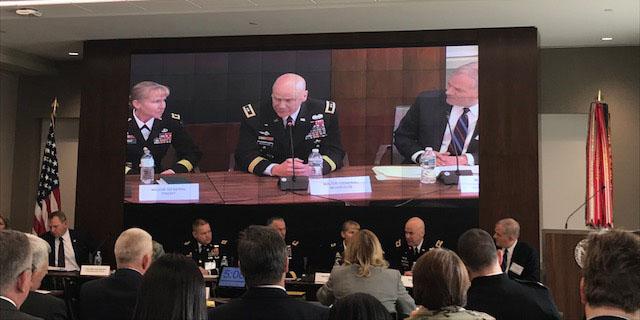Army Moves to Integrate Warfare Operations
The Army is looking to combine electronic warfare capabilities with intelligence and cyber capabilities, military leaders reported December 13 at AUSA’s Institute of Land Warfare discussion, The Future Force Build and Integration of Electronic Warfare and Information Operations Fields into Cyber. AUSA hosted the event at its headquarters in Arlington, Virginia, as part of its Hot Topic event series.
“It’s all about integration,” said Maj. Gen. John Morrison, USA, commanding general, U.S. Army Cyber Center of Excellence and Fort Gordon. “It is really integrating requirements, integrating capabilities into formations so that you can have a combined armed effect inside cyberspace. The integration of intelligence, cyberspace, electronic warfare—and I would submit to you signal as well—because you need all of those to come together if you are really going to deliver the effects you need.”
The Army gained important Joint Requirements Oversight Council (JROC) approval December 12 to move ground-based electronic warfare (EW) efforts into the Terrestrial Layer Intelligence System (TLIS) effective October 1, 2018, Gen. Morrison told the event attendees. The move will leverage the Army’s existing Multi-Function Electronic Warfare (MFEW) structure. The Army will then move to bring the air component of EW for JROC’s consideration later in the fiscal year.
With requirements validated and approved, the Army will move to field EW capabilities to the force. “We are already moving in that direction now,” he said. “We will start with our mobile unit training teams next month.” Gen. Morrison stressed that the integration is aimed at cross-function teams, a newer approach for the Army.
To Maj. Gen. Patricia Frost, USA, director of cyber, Office of the Deputy Chief of Staff, G-3/5/7, it is all about making systems, process and programs that endure. “This is not a quick reaction capability only for one year,” she said. “We understand the frustration in the field, but we’ve asked them to have a little tactical patience.” For the Army, this will be “a tremendous year of delivery of prototypes to the field,” she stated.
Moreover, in fielding these capabilities, it has “really been a team of team approach,” Gen. Frost said. “The Army cannot go forward in this space, cyber operations, EW and information operations, and the changes we need to make in signals intelligence, without partners. We need academia and we need industry—and our operators working on how the threat is evolving in different theaters—if we are going to get ahead.”
Gen. Raymond Thomas, USA, commander, U.S. Special Operations Command (SOCOM) recognized initial success in the U.S. Army’s move into the cyber realm as part of military operations but warned that cyber is only going to become more challenging. “We have made significant strides so far, but we need to be so much better,” he said. In special operations, they are applying cyber into “everything” they do. “We don’t think of cyber as a niche area,” and this change in mindset is crucial. “We’ve seen huge improvements, and the timeline on the battlefield is being compressed.” Recently SOCOM cyber exercises aimed at disruption on an “epic scale” reaped “exquisite effects,” the general said. He recommended that the U.S. military do these types of exercises all of the time.
The U.S. is limited by the policy and processes, which are not inhibiting our adversaries, Gen. Thomas added. “We are a nation of laws,” he said, and our ideals are not shared by countries that have made it their nation-state policy to affront massive cyber attacks. “The Sputnik race is now in cyberspace,” he said. The other challenge is how global the battlefield is, and how adversarial attacks move with the speed of electrons.
As such, the U.S. must mitigate any vulnerabilities at the same time as working to dominate the cyber landscape—a tall task. Cyber defense is paramount, then the U.S. must mount attacks and exploit cyber weaknesses, combing a portfolio of kinetic strikes and cyber attacks. “We need to embrace technology as a central essential weapon in our arsenal,” he said. “We need to keep pace, akin to steps taken in the post-9/11 attacks.”
Gen. Thomas added that the U.S. has the technology for the battle. “It is not the case that we don’t know how to use it,” he said. “It is our acquisition processes that might be too slow. We need an agile acquisition approach.”
In addition, the Army must be flexible in the cyber battle, and place trust in cyber teams and mission command. And certainly, the message must come not just from the very top. “Absolutely, this is a commander problem, not just a J-6 problem. We have to arm our commanders in all areas. We can do this to dominate, with the right teams, talent and tasks.”





Comments